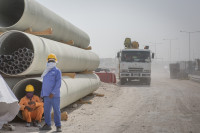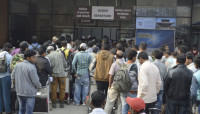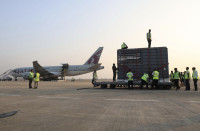Columns
On the farmers’ protest in India
It is undeniable that Indian farming has been in a state of crisis for some time now.
Kashif Islam
It has now been many months that Indian farmers from the surrounding states of Punjab and Haryana have camped outside the capital New Delhi to force the government’s hand on the farm bills. Multiple rounds of talks between farm leaders and the government have proven inconclusive. While the government has gone so far as to postpone the implementation of the laws by 18 months, farm leaders have been adamant on repealing them.
The three laws in question were hurried through Parliament by the government in what has now become the norm. There was little prior discussion, no scrutiny by parliamentary committees, and little effort at building consensus with other stakeholders. The job of manufacturing opinion was left to the massive state machinery and a pliant news media. Activists and farm leaders voicing their concerns were charged with conspiracy in the employ of foreign agents aimed at creating unrest in the country.
Differing views
The agitating farmers believe that the new regime of farm procurement would ultimately kill the minimum support price and public procurement for food grain. Their leaders say that the entry of private players into farm procurement and storage would leave the already vulnerable farmers at the mercy of corporate interests. The government, on its side, insists that the entry of private entities would free the farmers from the mandis and middlemen and open new avenues for their produce.
Whatever the validity of the farmers’ concerns, it is undeniable that Indian farming has been in a state of crisis for some time now. The high cost of agricultural inputs, frequent crop losses, and uncertain prices have plunged millions of marginal and subsistence farmers into poverty. Rural indebtedness remains high despite periodic loan waivers by the government. Not surprisingly, hundreds of thousands of farmers abandon farming every year; those who stay back often do so because they have no other option.
Even support programmes like the minimum prices offered by the government cover only a small fraction of the farmers owing to lack of attractive prices or difficulties in moving the produce to the designated procurement centres. It is no surprise that the farmers protesting at the moment are precisely from the states of Punjab and Haryana which have very high coverage of public procurement.
The precarious state of the farming sector has to be juxtaposed with the imperative of producing enough food at affordable prices for a population of 1.3 billion and growing, a good proportion of which are covered by the subsidised food grain programmes of the government.
The economists’ prescription for this is a simple, if brutal, one of getting people off farming. Basing themselves on productivity, the experts believe there are just too many people trying to make a living off the land. They cite figures from the developed countries where less than 5 percent of the people are engaged in agriculture. The figure remains at over 50 percent for a developing country like India while contributing under 20 percent to the national GDP. The government's programme to double farm incomes in the next few years also relies heavily on moving people out of agriculture. Though, in the absence of growth of Indian manufacturing, it is not clear which sectors will absorb the millions of unskilled marginal farmers.
Even before thinking about the applicability of this proposal to the developing countries, it will be instructive to look at how the developed countries have fared. Despite very high productivity (an acre of land in the United States produces three to four times the wheat produced on an Indian farm), a viable landholding there is a farm of a minimum of 1,000 hectares. Family farms with a few hundred hectares, a large enough size for most other countries, find it very difficult to survive and have consistently declined over the past few decades. And this despite government support and subsidies.
In the European Union, farming continues to be fraught with high risk and uncertain income. As in the US, over-supply and the globalisation of markets have led to shrinking incomes, especially for independent farmers, many of whom manage to barely stay afloat thanks to subsidies provided by the EU. Ironically, these very same Western countries who continue to support their agricultural sectors call for ending minimum support prices and subsidies in countries like India.
It is obvious that it will not be possible for a developing country like India to halve the proportion of people engaged in agriculture to 25 percent. Even so, the Western experience with agriculture with fewer people and high-capital dependence shows us several things.
Not what it seems
First, increased productivity from large farms does not automatically mean higher incomes for the farmers. There is frequently over-production, and in the absence of domestic demand, the excess produce has to be offloaded at the prevailing global prices, often at a loss to the producer. Second, contrary to expectations, the entry of organised private players into buying farm produce directly from the farmers often leads to lower and not higher farm prices despite having fewer intermediaries. French and German supermarkets are notorious for offering very low prices to the farmers.
Given the highly complex nature of the problem with ramifications for food security and the livelihood of millions of people at stake, the government should certainly have attempted to build consensus and taken more stakeholders on board before enacting the laws. But then, the government did not probably anticipate the scale of the protests, misguided or not, by those affected by the potential loss of income and land.




 18.12°C Kathmandu
18.12°C Kathmandu













%20(1).jpg&w=300&height=200)

